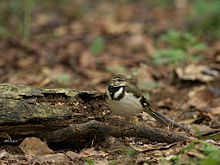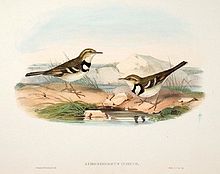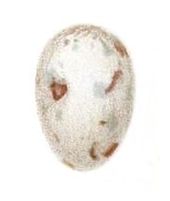- Forest Wagtail
-
Forest Wagtail 
Conservation status Scientific classification Kingdom: Animalia Phylum: Chordata Class: Aves Order: Passeriformes Family: Motacillidae Genus: Dendronanthus
Blyth, 1844Species: D. indicus Binomial name Dendronanthus indicus
(Gmelin, 1789)Synonyms Limonidromus indicus
Motacilla indica
Nemoricola indicaThe Forest Wagtail (Dendronanthus indicus) is a medium-sized passerine bird in the wagtail family Motacillidae. It has a distinctive plumage that sets it apart from other wagtails and has the habit of wagging its tail sideways unlike the usual up and down movements of the other wagtail species. It is the only wagtail species that nests in trees. They are found mainly in forested habitats, breeding in the temperate parts of east Asia and wintering across tropical Asia from India to Indonesia.
Contents
Description
This is a distinctive wagtail, the only one placed in the genus Dendronanthus (all other wagtails are placed in Motacilla). The Forest Wagtail is 18 cm in length, a slender bird with a long tail. The back and crown are olive brown, and the wings are black with two yellow wing bars and white tertial edges. There is a white supercilium, above a dark stripe through the eye. The underparts are white, apart from a black double breast band. The upper breast band is bib-like while the lower band is often broken. Sexes are similar. Young birds show more yellowish on the underside.[2]
Distribution and habitat
As its English and scientific names imply, this is a forest species, a distinction from all other wagtails. It is usually found in open areas of the woodland such as clearings. In winter it is found mainly in well-shaded forest habitats or along paths in coffee plantations and clearings in forests.[3]
The breeding areas are in eastern Asia, parts of Korea, parts of China (Kansu, Anhwei, Hunan) and parts of Siberia. Southern records of breeding from Assam have been questioned. It migrates to the warmer parts of Asia in winter and it has been suggested that they reach southern India and Sri Lanka via the Andaman Islands.[4] It has been recorded as a vagrant in the Maldives.[5]
Behaviour and ecology
These wagtails are found singly or in small groups. They often forage in the trees and capture insects along the branches of trees. They may also forage on the ground like a pipit and when disturbed, it flies up into the trees with a sharp pink note. They roost in the company of other wagtails among reeds.[3] The song includes disyllabic tsi-fee notes repeated several times.[6] They can climb steep branches and will run rapidly along horizontal branches.[4]
The breeding season is May in northeastern India and June in the Amur region. The Forest Wagtail leaves the winter quarters towards the end of March from Sri Lanka and mid March from the Malay Peninsula. The last birds leaving around May. During particularly cold springs, the arrival in the summer breeding grounds near the Kedrovaya River (Ussuri Land) can be as late as the end of May. Males sing from May to July, and when calling the bird sways at each syllable. It is the only wagtail that builds nests on trees, often favouring oaks. It builds its cup-shaped nest made up of fine grass and rootlets matted with moss and cobwebs. The nest is built by the female alone and the male stands guard nearby. The usual clutch is five eggs, incubated by the female alone for about 13 to 15 days. Incubation begins before the full clutch is laid and the eggs hatch at intervals. The young fledge and leave the nest after about 10 to 12 days. Both the males and females take part in feeding the young. Like other wagtails, this species is insectivorous.[3][4][7]
Apart from its unusual plumage pattern and habitat, the Forest Wagtail differs from its Motacilla relatives in its strange habit of swaying its tail from side to side, not wagging it up and down like other wagtails. The Japanese name Jokofury-sekirei (=sideways-swinging wagtail) ) is based on this habit.[4] In Sri Lanka, they often search for maggots in cattle dung and for this reason are known as gomarita (=dung-spreader).[8]
The Brown Shrike (Lanius cristatus confusus) sometimes imitates the calls of the Forest Wagtail.[4]
References
- ^ BirdLife International (2008). Dendronanthus indicus. In: IUCN 2008. IUCN Red List of Threatened Species. Downloaded on 29 November 2010.
- ^ Baker, E C Stuart (1926). The Fauna of British India, Including Ceylon and Burma . Birds. Volume 3 (2 ed.). pp. 275–277. http://www.archive.org/stream/BakerFbiBirds3/BakerFBI3#page/n299/mode/1up.
- ^ a b c Ali, S. & S.D.Ripley (1998). Handbook of the Birds of India and Pakistan. Volume 9 (2 ed.). New Delhi: Oxford University Press. pp. 277–280.
- ^ a b c d e Neufeldt, Irene (1961). "The breeding biology of the Forest Wagtail, Motacilla indica Gmelin". Journal of the Bombay Natural History Society 58 (3): 559–588.
- ^ Anderson, RC & M Baldock (2001). "New records of birds from the Maldives, with notes on other species". Forktail 17: 67–73. http://www.orientalbirdclub.org/publications/forktail/17pdfs/Anderson-Maldives.pdf.
- ^ Hoffmann, A (1952). "Ueber den Gesang der Indischen Baumstelze Dendronanthus indicus (Gmelin)" (in German). Bonner Zool. Beitr. 1-2 (3): 11–16.
- ^ Austin, O L (1948). "The birds of Korea". Bulletin of the museum of comparative zoology 101: 1–302. http://www.archive.org/stream/bulletinofmuseum101harv#page/240/mode/1up/.
- ^ Jerdon, TC (1863). The birds of India. Volume 2. Part 1. The Military Orphan Press, Calcutta. pp. 226. http://www.archive.org/stream/birdsofindiabein21jerd#page/226/mode/1up/search/.
Other sources
- Voelker, G. & Edwards, S.V. (1998) Can weighting improve bushy trees? Models of cytochrome b evolution and the molecular systematics of pipits and wagtails (Aves: Motacillidae) Systematic Biology, 47, 589–603.
- Voelker, G. (2002) Systematics and historical biogeography of wagtails: dispersal versus vicariance revisited. The Condor, 104, 725–739.
External links
Categories:- IUCN Red List least concern species
- Motacillidae
- Genera of birds
- Birds of Asia
- Birds of Nepal
- Monotypic bird genera
- Animals described in 1789
Wikimedia Foundation. 2010.



